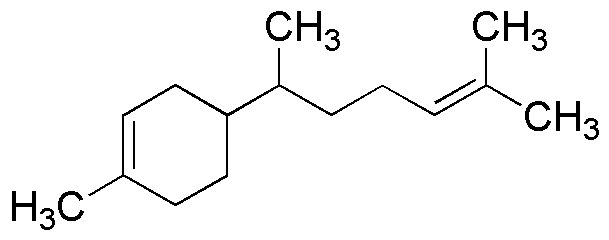Bisabolene is widely utilized in research focused on:
- Flavor and Fragrance Industry: This compound is a key ingredient in creating natural fragrances and flavors, providing a pleasant aroma in perfumes and food products.
- Pharmaceutical Applications: Bisabolene exhibits potential therapeutic properties, making it valuable in the development of natural medicines and supplements.
- Aromatherapy: Its soothing scent is commonly used in essential oils, promoting relaxation and wellness in various therapeutic practices.
- Cosmetic Formulations: The compound is incorporated into skincare products for its anti-inflammatory and skin-soothing benefits, enhancing product efficacy.
- Biotechnology: Researchers are exploring bisabolene as a biofuel precursor, aiming to create sustainable energy sources from renewable materials.
General Information
Properties
Safety and Regulations
Applications
Bisabolene is widely utilized in research focused on:
- Flavor and Fragrance Industry: This compound is a key ingredient in creating natural fragrances and flavors, providing a pleasant aroma in perfumes and food products.
- Pharmaceutical Applications: Bisabolene exhibits potential therapeutic properties, making it valuable in the development of natural medicines and supplements.
- Aromatherapy: Its soothing scent is commonly used in essential oils, promoting relaxation and wellness in various therapeutic practices.
- Cosmetic Formulations: The compound is incorporated into skincare products for its anti-inflammatory and skin-soothing benefits, enhancing product efficacy.
- Biotechnology: Researchers are exploring bisabolene as a biofuel precursor, aiming to create sustainable energy sources from renewable materials.
Documents
Safety Data Sheets (SDS)
The SDS provides comprehensive safety information on handling, storage, and disposal of the product.
Product Specification (PS)
The PS provides a comprehensive breakdown of the product’s properties, including chemical composition, physical state, purity, and storage requirements. It also details acceptable quality ranges and the product's intended applications.
Certificates of Analysis (COA)
Search for Certificates of Analysis (COA) by entering the products Lot Number. Lot and Batch Numbers can be found on a product’s label following the words ‘Lot’ or ‘Batch’.
*Catalog Number
*Lot Number
Certificates Of Origin (COO)
This COO confirms the country where the product was manufactured, and also details the materials and components used in it and whether it is derived from natural, synthetic, or other specific sources. This certificate may be required for customs, trade, and regulatory compliance.
*Catalog Number
*Lot Number
Safety Data Sheets (SDS)
The SDS provides comprehensive safety information on handling, storage, and disposal of the product.
DownloadProduct Specification (PS)
The PS provides a comprehensive breakdown of the product’s properties, including chemical composition, physical state, purity, and storage requirements. It also details acceptable quality ranges and the product's intended applications.
DownloadCertificates of Analysis (COA)
Search for Certificates of Analysis (COA) by entering the products Lot Number. Lot and Batch Numbers can be found on a product’s label following the words ‘Lot’ or ‘Batch’.
*Catalog Number
*Lot Number
Certificates Of Origin (COO)
This COO confirms the country where the product was manufactured, and also details the materials and components used in it and whether it is derived from natural, synthetic, or other specific sources. This certificate may be required for customs, trade, and regulatory compliance.

